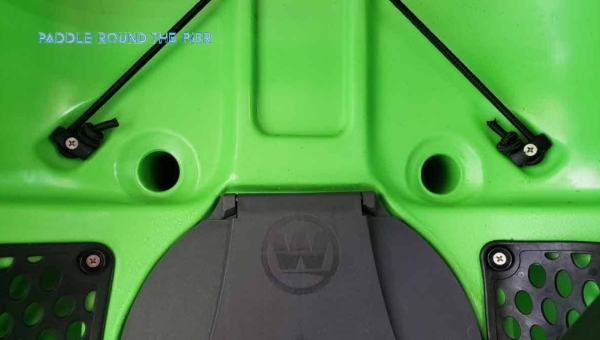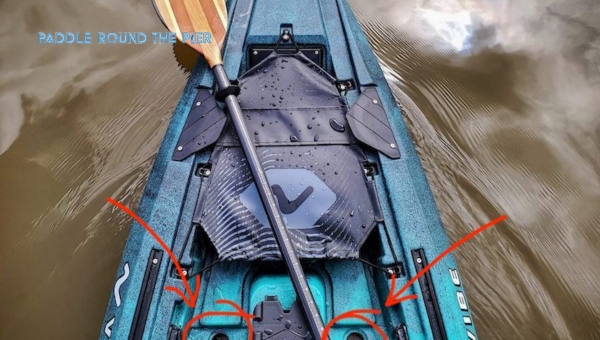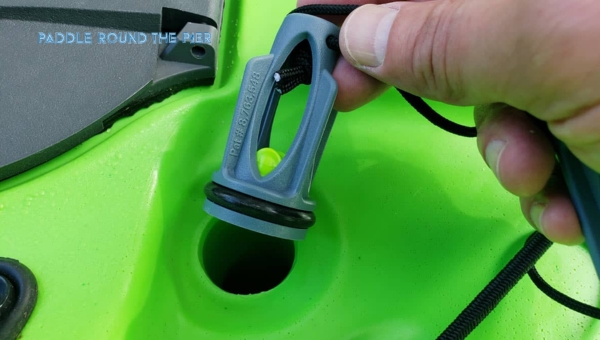Kayak Scupper Plugs: Essential Tips and Effective Techniques
As a wide-eyed kayaker, whether an expert or a beginner, have you ever wondered about the significance of those little holes in your kayak?
If you nodded, then it's time for an enlightening discussion about kayak scupper plugs. Nothing can dampen a paddling adventure faster than a swamped cockpit, and that's exactly where these little devices come in handy.
Kayak scupper plugs are specially designed for blocking scupper holes when needed. The ingenious design consists of small-sized stoppers used to seal off the drainage holes found typically at the bottom of sit-on-top (SOT) kayaks.
This device plays a crucial role in maintaining stability and controlling water entry, or outflow into or out of your kayak during paddling. They ensure that water drainage functions effectively to provide you with the safest and most comfortable kayaking experience.
Familiarizing Yourself with Kayak Scupper Plug Work
Venturing into the world of kayaking can be an incredibly rewarding experience. The sport gives you plenty to learn about, among them the crucial role played by certain kayak accessories like kayak scupper plugs.

What function do Kayak Scupper Plugs serve?
Before delving into the nitty-gritty, let's first define what these tiny yet essential components are. Kayak scupper plugs are essentially small devices designed to fit in and block off the scupper holes that are found in sit-on-top kayaks.
- Scupper holes: These are openings that help to drain water away from your kayak's deck or cockpit. They make it possible for water that splashes into your vessel to escape easily, keeping you dry and enhancing your paddling experience.
- Kayak scupper plugs: These act as closures for these holes when needed. They provide flexibility and control over how much water is allowed inside based on current weather conditions and personal comfort level during paddle sports.
The Role of Scupper Plugs in Kayaking
Understanding why I need to use kayak scupper plugs not only informs my choice of accessories but also maximizes my enjoyment of this vibrant paddle sport. Here's how:
- Water drainage: By controlling how much water gets drained through the holes, we have significant control over our amberjack adventure's dryness levels.
- Stability and balance: While cooking up wild waves, a substantial amount of water can end up inside our vessels affecting stability. Scuppers come in handy because they maintain a balance between keeping us dry internally without risking unwanted buoyancy changes.
- Enhanced safety: Understanding when to seal off those scuppers means we stay afloat longer even when Mother Nature decides on rain or choppy waters! Therefore, carefully using our seals enhances safety during unexpected scenarios when out on the water.
Types of Kayak Scupper Plugs
When it comes to kayak scupper plugs, two primary options exist commercially available models and do-it-yourself (DIY) versions. Each has its distinct features, advantages, and potential downsides that you need to understand to ensure you're making an informed decision for your paddle sports gear.
Commercially Available Kayak Scupper Plug Models
Several brands specialize in manufacturing kayak accessories, including scupper plugs. These are some common types that you’ll find in the market:
- Universal Scupper Plugs: One popular model is the universal scupper plug. These are designed to fit a wide range of kayaks irrespective of the brand or model. They're flexible, which maximizes their adjustment capabilities, ensuring a tight water seal.
- Brand-Specific Scupper Plugs: Some manufacturers produce proprietary plugs specifically designed for their kayaks. These often provide a more precise fit due to the targeted design, which can enhance stability and security within specific models.
- Adjustable Scupper Plugs: Another option you'll find readily available are flexible plugs. These can be manually adjusted for depth or diameter thus providing a snug fit regardless of the size of your scupper holes.
- Inflatable Rubber Scuppers: If you want an extremely tight seal on your drain holes, consider these kinds. Once inserted into the hole then inflated with air until they fill it.
Each type has its unique benefits essential in enhancing paddling efficiency whereas drawbacks may include price range differences and inaccurate fitting due to generic designs at times.
DIY Kayak Scuppers Plugs
If purchasing commercial kayak scuppers doesn't appeal to you or maybe feels like stretching your budget too thin? Don't worry! I have got something exciting; creating your very own DIY scupper plugs at home!
Here's a simple step-by-step guide:
- Material Collection: Gather all the necessary materials. You'll need a cork or rubber stopper of appropriate size and a piece of cord nowadays easily available in hardware stores.
- Hole Drilling: Using a drill, create a hole in the center of your cork or rubber stopper. This hole should be wide enough to accommodate your cord.
- Cord Insertion: Thread the cord through the hole you’ve just drilled. For easier handling, ensure that the cord is long enough for manipulation when installed on your kayak.
- Secure Cord Ends: For a firm grip especially while pulling them out from scupper holes later, secure both ends of the cord by tying knots.
- Test Before Use: Finally, before hitting water bodies with your DIY creation, do some testing off-water to ensure they fit correctly into your scupper holes and can be easily removed when required.
Also Read: Kayak Maintenance Guide: Expert Tips for Hull Care & Wax
Tips for Using Your Kayak Scupper Plugs
Running into problems with water drainage or stability while out on a kayaking trip can dampen the fun. That's why it's paramount to understand how best to employ kayak scupper plugs.

Let's delve into some tips on efficiently handling these essential kayak accessories for safer, hassle-free adventures on the water.
Proper Installation Techniques for Kayak Scupper Plugs
Proper installation of scuppers is the first step towards enjoying stress-free kayaking excursions. Missteps during this process can lead to water leakages or even loss of balance during your paddling sessions.
- Identify Your Vessel's Scupper Holes: Begin by identifying where your kayak's scupper holes are located. These are often placed in the cockpit and tank well areas.
- Select Suitable Plugs: Not all plugs will fit every type of kayak perfectly; thus, you may have to try a variety, of testing different sizes and shapes before finding the perfect fit.
- Install The Plug: Once you've identified a fitting plug size, install it from below but be careful not to push too hard as it can damage both hole and plug- aim for snug not tight.
- Ensure Water-Tightness: Post installation, ensure it provides sufficient sealing by checking if there are any visual gaps or if a water landmark is visible when filled up with some water.
- Safety First: Always endeavor to remove these plugs after use and rinse them as well as the holes they plug off with freshwater ensuring no grime buildup that could impair water-tight seal in future usage.
A common error that people make is ignoring the compatibility between their vessel’s scupper holes and their chosen plugs causing unsightly leaks or poor performance in rough waters.
Maintaining Your Kayak Scupper Plugs
Quite like other paddle sports gear we use, proper maintenance of the kayak scupper plugs is pivotal for their longevity and performance.
- Regular Checks: Regular inspections are necessary to ensure your scupper plugs operate at peak performance. Look out for wear and tear, any ill-fitting or loose plug can result in excessive water seeping into the kayak, potentially compromising safety.
- Cleaning Techniques: It doesn’t end at just regular checks, proper cleaning of these small but essential parts goes a long way too. Using fresh water to rinse off salt and grime from your recent adventure helps prevent corrosion or buildups that could impact water drainage in kayaks.
- Storage: When not in use it's best to stow them safely away in a cool dry place- A small but vital step often overlooked causing degradation faster if improperly stored.
Also Read: Kayak Trolling Motor Mount Installation: Your Simple Guide
Troubleshooting Common Issues with Kayak Scupper Plugs
As with any part of your kayak, you may encounter some troubles with your kayak scupper plugs after some time. Two common issues include leaky scuppers and struggles with obtaining the right fit for your kayak. However, tackling these complications can be simpler than it appears.

Addressing Leaky Kayak Scupper Plugs
That little occasional drip or a steady trickling water underneath you when paddling isn't music to anyone's ears. Leaking can be alarmingly common, but thankfully, there are several effective strategies to remedy leaky scupper plugs.
- Re-Installation: If the plugs initially seemed snug upon installation but are now leaking, it might be a case of poor installation. Ensuring that the plug is seated firmly in the hole and not just popped into place should rectify the issue.
- Foam/Accuracy Adjustments: Occasionally, minor adjustments can seal up those pesky leaks. Using foam discs or rubber rings (commonly available from paddle sports gear shops) around the plug before installing it can help fill gaps leading to leaks.
- Replacement: The material in older kayak scupper plugs shrinks or erodes over time - making them less efficient at keeping out water. Regular replacement as an element of overall scupper hole maintenance should keep such leakage problems at bay.
These troubleshooting tips should resolve typical problems easily yet save you soaking trips on the water!
Determining The Right Scupper Plug Size for Your Kayak
Finding a snug fit for your particular vessel model when sealing scupper holes is absolutely crucial for balance and ease on the waters.
- Measure Hole Size: Begin by measuring across the diameter and depth of each hull hole using calipers or tapes.
- Match Plug Size: Generally, most commercially available kayak accessories have their sizes listed online or on packaging. Choose one whose dimensions match closely with those of your scupper holes.
- Benefits of Adjustable Plugs: If precise matching seems difficult, adjustable kayak scupper plugs are a great alternative. They offer flexibility in size adjustments and can mold to fit your kayak's scupper holes more snugly, ensuring better water drainage in kayaks.
Also Read: Uncover The Beach Wagon: Guide to Coastal Comfort & Pleasure
FAQs
What happens if you do not use scupper plugs in a kayak?
Without kayak scupper plugs, water can enter your kayak through the scupper holes. This might overload the kayak, leading to instability or even sinking in extreme cases.
How can I tell if my kayak needs scuppers?
When you see water accumulation inside the hull of your kayak, it indicates that you need to put in place proper scupper plug use. In contrast, kayaks designed with self-draining features may not require them.
Can I kayak without scupper plugs?
Yes, you can still paddle without using the additional kayaking gear. However, keep in mind that this will cause water to splash into your vessel continuously and possibly interfere with your overall experience.
Can you plug all the scuppers in a kayak?
While it's possible to plug all the scuppers in a kayak, it's generally advisable only to seal those directly beneath your seat. Having some open allows for efficient drainage while maintaining optimum boat stability during paddle sports.
Conclusion
Going off the beaten path into the world of kayaking necessitates understanding every bit and piece that makes up your vessel. Kayak scupper plugs are fundamental accessories for ensuring that your kayak remains buoyant and robust in the mighty waters.
They help optimize your boat's performance and deliver safety advantages, among other vital roles. As you delve deeper into the paddle sports gear market or even consider creating homemade units, remember to prioritize quality, appropriate sizing, correct installation, and regular maintenance. Overcoming common challenges like leaky plugs translates to numerous enjoyable hours on the water.
